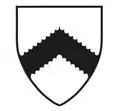David Holbache
Dafydd ab Ieuan (c. 1350 – 1422/23[1]), better known by his English name David Holbache, was a Welsh politician, best known for founding Oswestry School in 1407.
David Holbache | |
|---|---|
 Arms of David Holbache | |
| Member of Parliament for Shropshire | |
| In office 1406–1411 | |
| Preceded by | John Burley & John Darras |
| Succeeded by | John Burley & Sir Adam Peshale |
| Member of Parliament for Shrewsbury | |
| In office May 1413 – April 1414 | |
| Preceded by | Thomas Pride & John Whithiford |
| Succeeded by | Thomas Pride |
| Member of Parliament for Shropshire | |
| In office April 1414 – 1415 | |
| Preceded by | Robert Corbet & Richard Lacon |
| Succeeded by | Hugh Burgh & George Hawkstone |
| Member of Parliament for Shrewsbury | |
| In office 1417–1419 | |
| Preceded by | William Horde & Robert Horseley |
| Succeeded by | Robert Corbet & David Rathbone |
| Personal details | |
| Born | c. 1350 |
| Died | 1422 (aged 71–72) |
| Nationality | Welsh |
| Spouse | Gwenhwyfar ferch Ieuan |
| Residence | Dudleston & Oswestry |
| Occupation | landowner, lawyer, politician, educator, philanthropist |
Family background
Dafydd, was born in the mid-14th century to Ieuan "Gôch" ap Dafydd ab Iorwerth and Angharad ferch Iorwerth ap Griffri "Fychan".[2][1][3] His father's family had been seated at Pentrehylin, Dudleston, near Ellesmere, Shropshire since the early 13th century.[2] Pentrehylin means 'Helyin's village' in English and is named for Holbache's ancestor Heilin ap Trahaearn ab Iddon. Heilin ap Trahaearn claimed descent from Tudur "Trefor" ab Ynyr, a 10th-century lord of Maelor Cantref and a founder of one of the Fifteen Tribes of Wales. His mother's family also claimed paternal descent from Trahaearn ab Iddon.
His inheritance was assumed by his uncles, Einion "Goch" and Madog "Goch".[3]
Career
Holbache first appears in 1376 as a legal advisor to the Earl of Arundel, who held the Lordship of Oswestry.[1] He likely adopted the surname of Holbache to assist his assimilation into the English-controlled systems of governance, which limited opportunities and privileges for Welshmen. On 27 October 1377, he entered the acting service as King's pleader and attorney for Wales.[1] In this capacity it is known he served as a commissioner for gaol delivery in Conway.[1]
He was a member of parliament for Shropshire from 1406 to 1410 and in 1414.
In 1409 he was Deputy Steward of the Marcher Lordship of Bromfield and Yale.[3][4]
Oswestry School
In 1407, David and his wife, Gwenhwyfar ferch Ieuan, entrusted some of their lands situated in the Oswestry lordship to pay the wages of a schoolmaster, establishing what was to become Oswestry School.[5] The school premises were a half-timbered building within the grounds of St. Oswald's Parish Church. The building still stands today and is the location of a heritage centre.
Due to poor record keeping, little written documentation survives for the school up until relatively recent times. The headmasters of the school are unknown for the first 154 years of the school's history. Documentation relating to the school increases slightly after the unification of England with Wales under the English crown.
Marriage, issue and legacy
At around the turn of the 14th century he married Gwenhwyfar ferch Ieuan ab John (in English, Guinevere), of Sweeney, in Oswestry Parish, who brought with her lands in Sweeney, Treflach and Maesbury.[1] By this marriage or by another women of the same name he is attributed a daughter, Gwensi, who is said to have married Robert Salter, of Oswestry. However, this is believed to be an invention, Holbache being recorded as dying without issue.[3] His will, which was made 10 September 1421, was proved on 7 April 1423, but is no longer extant.
References
- History of Parliament Online – Holbach, David
- Welsh Genealogies, AD 300–1400 (1980), Bartrum, Peter C.: University of Wales Press, 1980, vol. 12 p. 896
- The History of the Princes, the Lords Marcher and the Ancient Nobility of Powys Fodog and the Ancient Lords of Arwystli, Cedewen and Meirionydd, Lloyd, Jacob Youde William, vol. 4 p. 93
- Jenkins, Robert Thomas (1959). "HOLBACHE ( HOLBECHE , etc.), DAVID". Dictionary of Welsh Biography. National Library of Wales. Retrieved 10 May 2018.
- Introduction to the History of Oswestry School